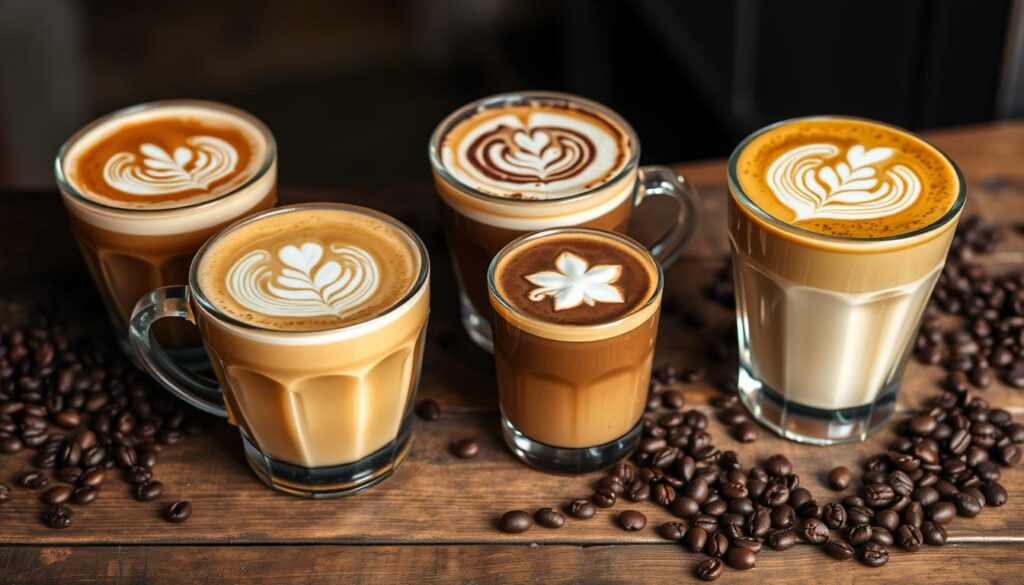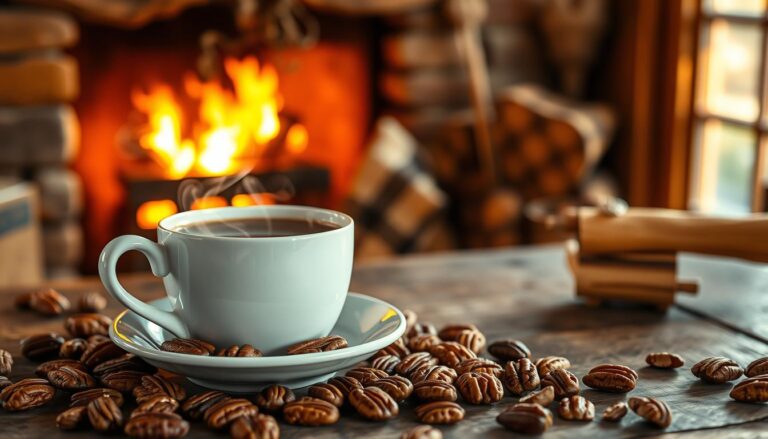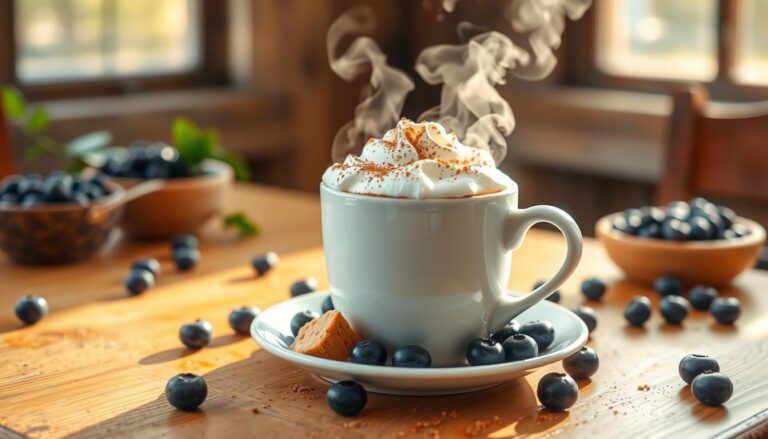If you love coffee, you’ve probably tried a latte. But have you wondered if it has caffeine? Knowing how much caffeine is in lattes is important, mainly for those watching their caffeine intake. We’ll explore lattes and find out if they have caffeine.
Key Takeaways
- Lattes contain caffeine, with a typical 16-ounce latte containing around 173 mg of caffeine.
- The caffeine in a latte comes from the espresso shots used in its preparation.
- Factors such as the number of espresso shots, milk type, and serving size can affect the total caffeine content of a latte.
- Lattes generally contain less caffeine than a cup of brewed coffee, but more than a traditional macchiato.
- Latte variations, like iced or matcha lattes, may have different caffeine levels depending on their ingredients.
What a Latte Is
A latte is a favorite coffee drink made of espresso and steamed milk. It has espresso, steamed milk, and a thin milk foam on top. This mix makes a smooth, creamy, and indulgent coffee drink that many enjoy.
How Lattes Are Made
To make a latte, baristas first pull a shot of espresso. Then, they add steamed milk over the espresso for a perfect blend. The drink is topped with a light milk foam, adding texture and beauty.
Traditional Latte Preparation Method
The traditional latte-making method is special. Baristas pull a single or double shot of espresso, based on the strength wanted. They steam the milk to a silky texture. The milk is then poured over the espresso, creating layers and a beautiful look. The drink is finished with a thin foam layer, adding indulgence.
“A well-made latte is a perfect balance of espresso, steamed milk, and just the right amount of foam. It’s a coffee drink that can be enjoyed any time of day.”
Does Latte Have Caffeine?
If you love coffee, you might wonder if lattes have caffeine. The answer is yes, lattes do have caffeine. This caffeine comes from the espresso shots used to make them.
A single shot of espresso has 63-100 mg of caffeine. The milk in a latte doesn’t add to the caffeine. The caffeine in a latte depends on how many espresso shots are used. This can change based on the coffee beans and brewing method.
“Lattes generally have less caffeine compared to straight espresso shots or brewed coffee due to the addition of milk.”
Lattes have less caffeine than espresso shots but they’re not caffeine-free. A 16 fl oz latte with a double shot of espresso has about 154 mg of caffeine. This is like 9.62 mg of caffeine per fl oz or 32.55 mg per 100 ml.
Compared to other caffeinated drinks, a 16 fl oz latte has more caffeine. It has more than Monster energy (160 mg), Red Bull (80 mg), instant coffee (60 mg), and Coca-cola (35 mg).
So, if you’re looking for a caffeinated drink, a latte is a good choice. It will give you a reliable caffeine boost for the day.

Caffeine Content in Different Latte Sizes
The size of your latte can greatly affect its caffeine content. Let’s explore how different latte sizes compare in caffeine levels.
Single Shot Latte Caffeine Levels
A single shot latte has about 63 mg of caffeine. This is because a single shot of espresso, the latte’s base, has around 64 mg of caffeine.
Double Shot Latte Caffeine Content
Many enjoy a double shot latte, often found in larger sizes. A double shot latte has about 128 mg of caffeine. This is due to the double shot of espresso, which also has about 128 mg of caffeine.
Factors Affecting Caffeine Amounts
Several factors can change the latte caffeine amount. These include the espresso beans, roast level, brewing method, and extraction time. Also, the size of the latte matters, as bigger sizes have more espresso and caffeine.

“You can safely consume three double-shot lattes in a day while staying under the recommended daily caffeine limit of 400 milligrams.”
Comparing Latte Caffeine to Other Coffee Drinks
A latte might surprise you with its caffeine content. It’s made with espresso, but a 16-ounce latte has about 173 mg of caffeine. This is close to what you’d find in a 16-ounce cappuccino. On the other hand, a 2-ounce macchiato has only about 85 mg of caffeine.
Latte and other espresso-based drinks usually have less caffeine than regular brewed coffee. An 8-ounce cup of brewed coffee has around 96 mg of caffeine. This is because espresso-based drinks use less coffee and add milk, which dilutes the caffeine.
“Lattes generally have less caffeine than a straight espresso shot or brewed coffee due to the addition of milk.”
The amount of caffeine in a latte can change based on several factors. The size of the drink, the espresso’s strength, and the milk-to-espresso ratio all play a role. Larger lattes or extra espresso shots can increase the caffeine content a lot.
Latte’s caffeine level is in the middle when compared to other coffee drinks. Knowing these differences helps you choose the right coffee for your day.
The Role of Milk in Latte Caffeine Content
The milk in a latte is key to its caffeine level. A latte has a 3.5:1 milk-to-espresso ratio. This means there’s a lot of milk compared to espresso. This ratio makes the latte less strong than a straight espresso shot.
Milk-to-Espresso Ratio Impact
A latte has one shot of espresso, which has about 63 milligrams of caffeine. But when you mix it with 3.5 parts steamed milk, the caffeine spreads out. This makes the latte have 63-175 mg of caffeine, depending on the espresso’s strength.
How Steamed Milk Affects Caffeine
Steaming the milk for a latte doesn’t add caffeine. It makes the milk creamy and softens the espresso’s strong taste. This mix of flavors is what makes a latte special.
Different Milk Types and Their Effects
- Whole milk: Makes the latte richer and creamier.
- Skim milk: Creates a lighter, less creamy latte.
- Plant-based milks (e.g., almond, oat, soy): Change the taste and feel of the latte but don’t change the caffeine.
The milk in a latte adds a smooth texture and balances the flavors. It doesn’t change the latte’s caffeine level much.
Popular Latte Variations and Their Caffeine Levels
There are many latte variations to try, beyond the classic espresso and steamed milk. You can explore flavored lattes and iced lattes. Each one has its own taste and caffeine level.
Flavored Lattes: Flavored lattes, like vanilla or hazelnut, have about the same caffeine as a regular latte. The syrups or powders used for flavor don’t change the caffeine much.
Iced Lattes: Iced lattes have the same caffeine as hot lattes, around 173 mg in a 16-ounce serving. The cooling process doesn’t reduce the caffeine, making them a great choice for a pick-me-up.
Latte Macchiatos: Latte macchiatos, with milk poured first and then espresso, might have a bit less caffeine. This is because of the different way they’re made, leading to a lower espresso-to-milk ratio.
“Latte variations offer a world of flavors and caffeine levels to explore, catering to a diverse range of taste preferences and caffeine needs.”
Whether you want a creamy, flavored latte or a cool iced one, knowing their caffeine content helps you choose. It’s a way to fuel your day with the right amount of energy.
Conclusion
Lattes do have caffeine, mainly from the espresso shots. The amount of caffeine can change based on the latte’s size, the number of shots, and how it’s made. Lattes give a good caffeine kick but have less than brewed coffee.
Knowing how much caffeine is in lattes and other coffee can help you choose wisely. Whether you like the creamy taste of a latte or the strong flavor of black coffee, knowing the caffeine levels lets you enjoy your coffee. It also helps you control how much caffeine you have.
As lattes become more popular around the world, coffee lovers can enjoy them. They can do so knowing they’re making smart choices about their latte caffeine summary, coffee drink choices, and caffeinated beverages.







